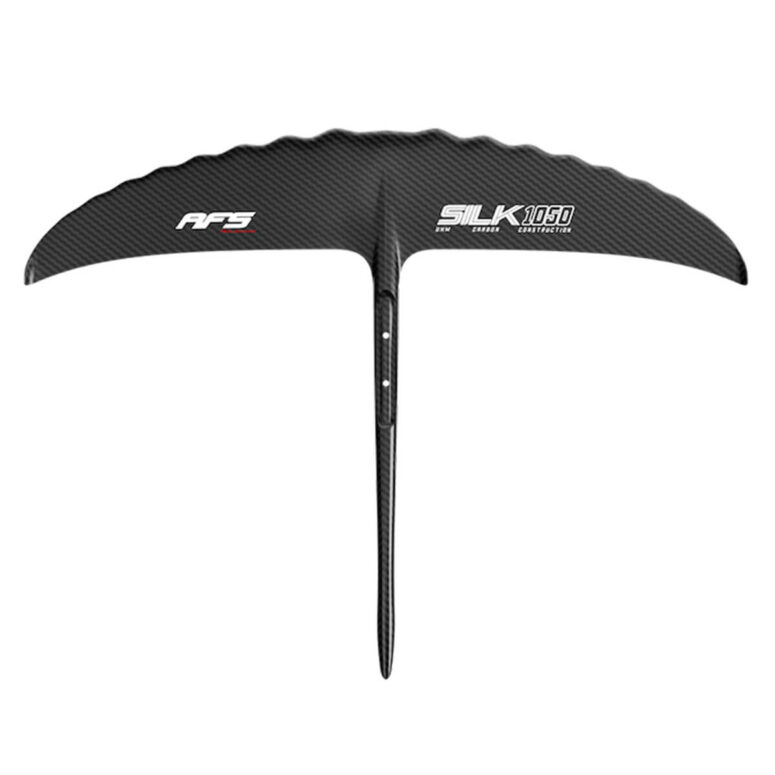

When you purchase gear through links on our site, we may earn a small commission. Here’s why you can trust our tests and our affiliate partner.

Laurent Borgna has a legacy of designing noteworthy foils with unique physical features; when you see his LOL logo gracing a front wing, there’s an automatic assumption it’s going to be something interesting. He’s recently joined forces with French manufacturer AFS for a collaboration on a surf-specific foil they’ve coined the Silk. There’s a concise range of three sizes available in 650, 850 and 1050cm2, all with an aspect ratio that transcends all three sizes set at a firm 8.0.
So what are we looking at technically? Construction is carried out in France, and the entire plane structure is formed in UHM carbon. Holistically, an eye has definitely been focused on a system with clean hydrodynamics and each structural junction is gently honed and blended.
Shape-wise, there’s obviously plenty going on with the front wing, with Laurent’s signature whale-inspired tubercles running along the whole leading edge. Some gentle upturned winglets are present and sit quite swept back, which offers more control of tip bleed. The theory behind the tubercles is, in essence, a smoother ride at more extreme angles of attack and an ultra-forgiving and sturdy ride across the speed range.
The front wing has a monobloc construction which includes the entire length of the fuselage, which keeps a narrow and sleek diameter throughout and blends gently into the front wing eliminating any potential hydrodynamic drag points. This has the benefit of a complete structure with no joins, meaning minimal loss of feeling through the system. Fuselage length is obviously dictated for you, but we found it matched the front wings in a balanced manner, eliminating any last minute decision making on the beach.
The bottom-mounted stabilizer hooks in with two M6 Torx bolts and its angle is fixed out of the box and it’s a set-and-forget affair. Again, this is extremely well-trimmed out of the box, and a case of trust your designer. The stabilizer also sports some tubercles matching the front wing. We ran the 152 stabilizer across the 1050 and 850 model front wings.
The mast-to-fuselage connection is a unique recessed, tapered socket design. It makes a good job of using the carbon structure to transfer the load rather than relying entirely on the bolts. Two M8 Torx bolts clamp the two surfaces together and the fit is excellent. Our rudimentary wobble tests to see if there’s any play in the area came back with no discernible movement and the mast has a satisfying ping to its reflex.
The UHM mast is both thin and stiff, 14mm to be exact through the bulk of its length. There’s a taper in the chord increasing gently up towards the pedestal, which hooks into the foil box with four M8 Torx bolts. AFS recommend the 80cm as standard with the Silk, which offered a well-tailored balance of surface clearance and maintained a tactile connection and feedback from the foil. As a system, it’s noticeably lightweight. A fully built 1050 system sat at 3kg on the scales.
Riding the Silk, particularly for a seasoned surf-focused rider, is nothing short of an absolute joy. It comes up to speed quickly and efficiently. The rail-to-rail carving ability and general blend of maneuverability hosts an innate feeling of security through deep and powerful turns and is going to really aid progression towards tighter maneuvers in the pocket at speed. It’s a foil that likes to be driven fast and hard, offering Subaru Impreza levels of grip – plant it into what seems like an implausibly tight turn and it plants itself and whips you out with speed. Switching between the 1050 and 850, the consistency is impressive, as the 850 is no more technical to ride, it just requires a little more power from the wind or wave.
Where some surf-focused systems lack the upper speed range to wingfoil comfortably with, the Silk transcends disciplines fairly effortlessly. With a wing, the Silk can be pushed faster than you’d anticipate, sporting a decent top end where it doesn’t become particularly unruly underfoot. An important factor for a wave-orientated foil is how well it handles white water and disturbed water states. It’s safe to say that the silk absolutely cruises it, further increasing your confidence to throw a harder turn where normally you’d be more pensive. Tip breach and recovery are predictable if you do want to smash some white water. Wave propelled, it affords a smooth take off, followed by a deep and slower pumping cadence, and is generally easy enough to connect waves with.
Whilst the design objective of the Silk has that unapologetically strong wave bias, where it evidently thrives, we felt that it worked well as an all-round foil across disciplines and is a testament to Laurent’s design experience. Couple that with the in-house European manufacturing at AFS and it’s unarguably a superb combination that should be a serious consideration for any wave aficionado.